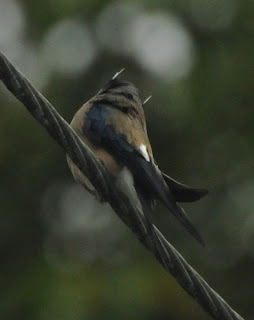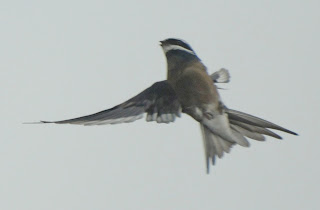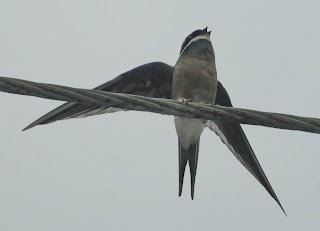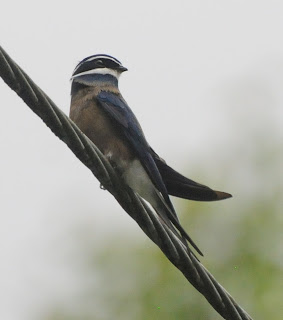In this case, it was September 7, 2012, and I was in the high country thanks to an invitation from my friend and co-birder Anthony Wong.
As always, a brief stroll along the road edges and forest tracks at Borneo Highlands gives me an excellent opportunity to display my botanical ignorance.
What, for example, are these fruits, sprouting from the trunk of a forest tree?
Or this striking, vaguely canna-like bouquet of butter-yellow flowers?
Or this truly impressive spherical inflorescence?
Or these globular fruits?
I can make a stab at some of these: this seems to be a species of Ixora (there are only about 500 to choose from).
This, by the form of its ladder-like leaf venation, is apparently a member of the Melastomataceae.
This is a ginger of the genus Etlingera - probably Etlingera coccinea. Its flowers sprout at ground level from a creeping underground rhizome, and you could be forgiven for not associating them with the leafy stems arching over their heads.
These startling orange-flowered vines are members of the genus Bauhinia - either Bauhinia bidentata or one of its near relatives.
This odd-looking plant is an umbrella or sun fern - a species of the genus Dipteris, probably D. conjugata. a member of a tiny (only 12 species) and very ancient fern family, the Dipteridaceae, ranging from tropical Asia to Australia.
Birds were a bit thin on the ground this time, and the only highland species I have to offer is this Cinereous Bulbul (Hemixos cinereus).
I had better luck with the lower orders, including this fine green scarab beetle.
The bearer of these impossibly elongate antennae is one of the bush crickets (Nisitrus sp.).
Satyrine butterflies are particularly common in Borneo forests. This is a Common Three Ring (Ypthima pandocus). The name refers to the number of rings on the underside of the hindwing.
At the Tea House on the resort grounds Anthony and I found an invertebrate of a different sort, probably driven out of the soil by recent rains.
It was one of Borneo's spectacular giant earthworms, of which the most well-known is the Kinabalu giant earthworm (Pheretima darnleiensis). Whether that is what this is or not (and there seems to be some confusion about the name) I wouldn't dare to say. For anyone who finds it odd to combine the words "spectacular" and "earthworm" in the same sentence, let me point out that the Kinabalu species grows to 70 cm in length (besides being blue).
His reply certainly explained my failure to come up with an ID: "Your Rhinocypha female seems to be the same as the new species from Kubah National Park, although it has broader antehumeral markings than any of the other females I have, either from Kubah or Penrissen." In other words, this is either a new species that is still awaiting description, or something else altogether. There is something wonderful about a place where you can find undescribed species by the side of the road!
Partway down the road from the resort, there is a pull-off by a rocky stream, with a trail (if you can call the bamboo structure in these photos part of a trail) to a waterfall-fed pool.
Growing among the rocks I found an assortment of ferns...
...and a species of balsam (Impatiens sp.). Note the long, slender nectar spur (the threadlike object hanging from the back of the flower), which ensures that only moths and butterflies with sufficiently long probosci can profit from visits (therefore reducing the range of pollinators, which in turn increases the chance that pollinators who do visit an Impatiens are likely to carry its pollen to a flower of the same species).
I found this little Black-spotted Rock Frog (Staurois guttatus) sitting on a rock above the stream, and managed to get a few quick photos before he became equally aware of me and disappeared. It is unusual, among similar frogs, in that it is active by day (which is undoubtedly why I found it).
Not far away Anthony spotted the hive of a colony of Giant Honeybees (Apis dorsata), reportedly among the most fearsome denizens of Borneo's rainforests. Fortunately, it was some distance away.
Near the bottom, we passed depressing evidence that Sarawak's forests are diminishing - all the more reason to bring them to the attention of the world. That's one of the reasons I write this blog. I love Borneo more every time I go back, and I hope that my readers, especially Malaysians whose heritage this is, will have their own chance to experience, be fascinated by, and cherish the things I have seen.
We were already out of the gate at the bottom of the road to Borneo Highlands, and on our way back to Kuching, when Anthony and I came across this little bird perched on an overhead wire. It was a Whiskered Treeswift (Hemiprocne comata), smallest of a family of four species at least partly differentiated from their cousins the true swifts by the fact that they can perch at all.
Here, just to illustrate the point, is a true swift - one of the hybrid swiftlets (Collocalia sp.) that swarm around Kuching as a result of the growth of swiftlet farming (their nests are the prime ingrediant in bird's nest soup). This one was right outside our doorstep - perhaps stunned after flying into a window. Anyway, notice that it isn't perching, but hanging. Despite what older books say, swifts do not have all four of their toes directed forwards all the time (which would make perching tricky), but they are still unable to perch. Treeswifts, though, perch very well indeed.
This view gives you a good look at the Whiskered Treeswift's whiskers.
Treeswifts have exceptionally long, narrow wings. When the bird is perched, they cross over each other, making the bird look as though it has a three-pronged tail - and giving it a very distinctive flight silhouette.
The Whiskered Treeswift is a bird of forests and forest clearings (more so than the other three members of its family), so this one must have been under the impression that the road passing through its wooded habitat amounted to a sort of clearing. Perching on wires is apparently a recently-acquired behaviour for this species (well, the wires are pretty recent themselves).
In September we were apparently near the end of the breeding season. Pairs of Whiskered Treeswifts defend territories; when a second bird joined the first I assumed that it was the other member of the pair, though it could have been a recently-fledged young (though young birds usually head off to find their own territories pretty quickly). I can't tell if these photos are showing pair-bonding or aggression; it looked like the latter, but perhaps a bit of both were involved.
Anyway, our visit with the treeswifts amounted to the closest encounter I have had with these pretty, yet odd-looking, little birds; they are not always easy to approach. For both Anthony and I, it was the birding highlight of a very pleasant day.

























































That has got to be the coolest earthworm with the highest squirm factor.
ReplyDeleteGreetings. Can I use one of your photos, the climbing Bauhinia bidentata for my blog post? A friend shared a photo of its flowers and I wanted to include yours as well. The blog is my 'online library' of plants :)
ReplyDelete